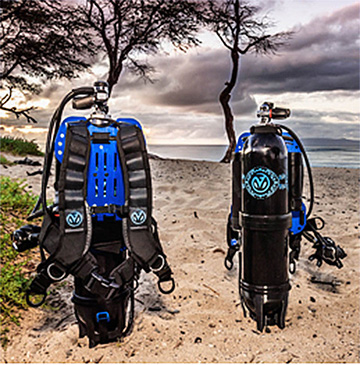Is This the End of the BCD?Contents of this Issue: Compass Point, Ocean Frontiers, Grand Cayman Is an Alex Mustard Workshop Right for You? Want to Enroll in an Underwater Photography Course? The Caribbean, Hawaii, the Galapagos, Florida Your Reader Reports are Important Florida Goliath Grouper Protection Battle Lost Do Great Whites Mate off the Carolinas? Save a Reef? Weed it Like You’d Weed a Garden Yucatan Cenotes in Danger of Destruction The Lionfish’s Fear of Being Eaten Lego Reveals the Longevity of Plastic in the Ocean Cancun Dive Boat Propellers Kill Two American Divers Editorial Office: Ben Davison Publisher and Editor Undercurrent 3020 Bridgeway, Suite 102 Sausalito, CA 94965 technology replacing simple physics? from the March, 2022 issue of Undercurrent
At each annual Dive Equipment and Marketing show, I look for what I call "The One DEMA Product." There's always someone optimistically offering a new revolutionary device that they hope with both revolutionize scuba diving and make them a fortune along the way. Few of these "innovations" show up at the next DEMA show, and presumably, their proponents are left disappointed. Next year, this year's well-promoted innovation may be no exception. As you know, a buoyancy compensator works by increasing or decreasing the displacement of the diver and his gear, altering the volume of gas in the BCD by adding or releasing air. A submarine works differently. Because of its fixed metal shell (its pressure hull), it has a fixed volume, and its mass (and therefore its buoyancy) is altered by either flooding chambers with water or expelling that water with stored compressed air. Hence the expression used in submarines: "Blow forward and aft in an emergency." The clue is in the term "blow." A company called Avelolabs.com reckons it's going to revolutionize scuba diving by bringing this submarine technology into play. It says, "Our lightweight [scuba] tank is buoyant and can become lighter or heavier by using water from its environment. Its operating concept is like a submarine that adds or removes water to maintain neutral buoyancy." Its website shows a graphic of a scuba tank with floodable sections and a battery-powered electric pump to introduce water as required. A good idea? Submarines use compressed air to blow the ballast water out. Ex-submariner and diver Eddie Clamp told Undercurrent, "It's a procedure used aboard a submarine that forces high-pressure air into its main ballast tanks." Out of the water, the system weighs 40 pounds. The Avelo diver carries a supply of air in a bladder within the lightweight outer hydrotank from which he breathes. At the surface, the lightweight hydrotank is positively buoyant, and the diver activates the pump to introduce water into the outer part of the tank in order to sink. The Avelo bladder has working pressure in excess of 4300 psi. (You'll need a DIN-fitting regulator to be able to use that safely.) It must expand to fill the space vacated by the water when 'blowing the tank" and pushing the water out via a purge valve. The manufacturer claims they've tested the system with thousands of dives with wetsuits up to 10 mm thick and drysuits, yet no weights were needed.
Martin Parker, the man behind what is probably the world's most successful closed-circuit rebreather, the A.P. Diving Inspiration, took a close look at it while he was at DEMA. He wrote to Undercurrent, "It's funny how some people think adding water will increase weight [when immersed in water. Decreasing the air-space (within the tank) will decrease buoyancy.] The battery pack will also be heavy. "I guess it's normal for people to assume if you fill [a tank] to 4,300 psi you'll get 50 percent more air [than a conventional fill of 3000 psi], but the real gas laws kick in and the compressibility of gases take over, so you only get about 30 percent more volume. (Experienced divers will know the way they burn through the first 50 bar on conventional scuba, compared to how long the last 50 bar lasts, when they're at the same depth.) "Incidentally, the idea is not new. There were two submarine type systems previously, one by Dacor and one by a small company in North Wales. They were both much bigger to get the buoyancy required. Neither required a pump and batteries." We're eagerly waiting to hear its expected retail price. The company is looking to sign up dealers and scuba educators and promises to reveal all later this year. In the meantime, our assessment is that, at best, it's a product using technology to solve a problem that does not exist. But only time will tell if this is the end of the conventional BC as we know it. https://diveavelo.com (For an explanation of gas laws go to: https://tinyurl.com/5n7kb2xp.) |

I want to get all the stories! Tell me how I can become an Undercurrent Online Member and get online access to all the articles of Undercurrent as well as thousands of first hand reports on dive operations world-wide
| Home | Online Members Area | My Account |
Login
|
Join
|
| Travel Index |
Dive Resort & Liveaboard Reviews
|
Featured Reports
|
Recent
Issues
|
Back Issues
|
|
Dive Gear
Index
|
Health/Safety Index
|
Environment & Misc.
Index
|
Seasonal Planner
|
Blogs
|
Free Articles
|
Book Picks
|
News
|
|
Special Offers
|
RSS
|
FAQ
|
About Us
|
Contact Us
|
Links
|
3020 Bridgeway, Ste 102, Sausalito, Ca 94965
All rights reserved.


